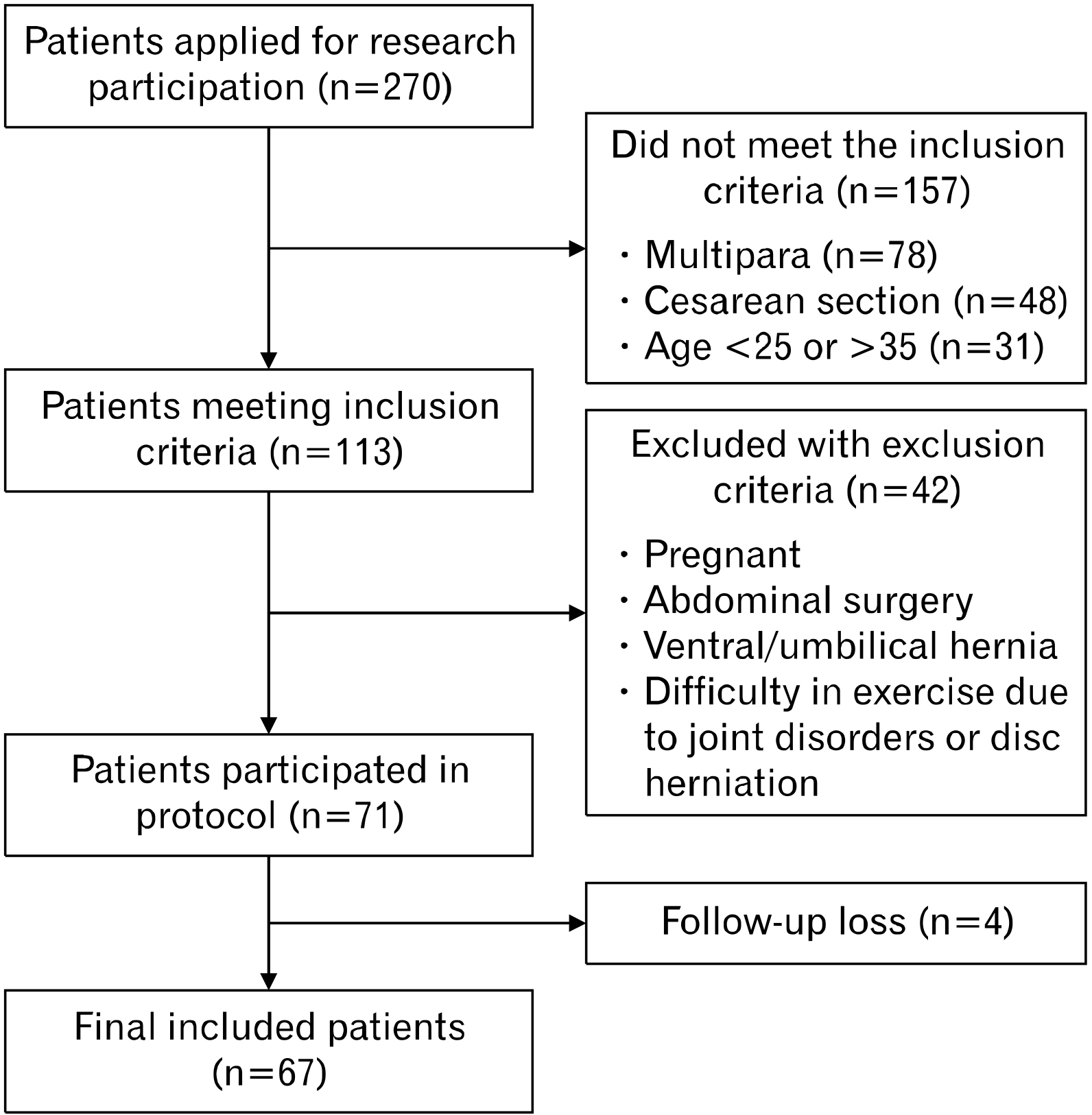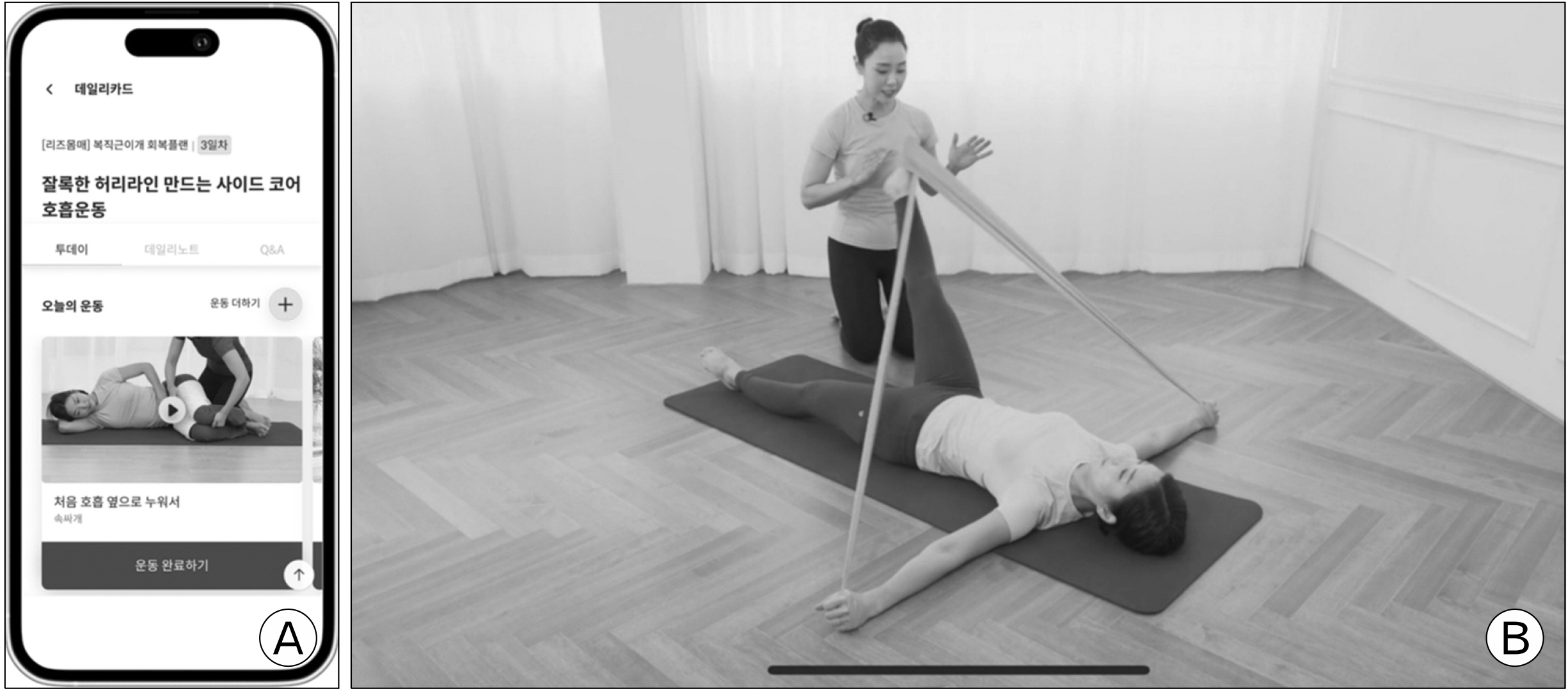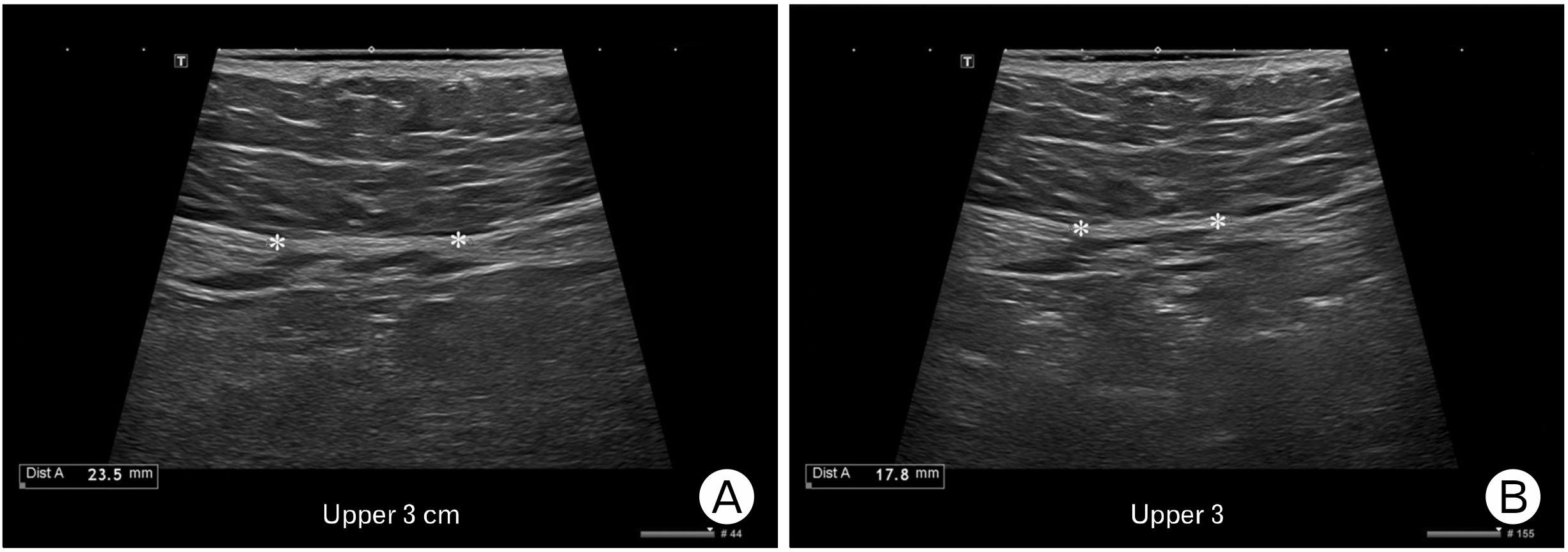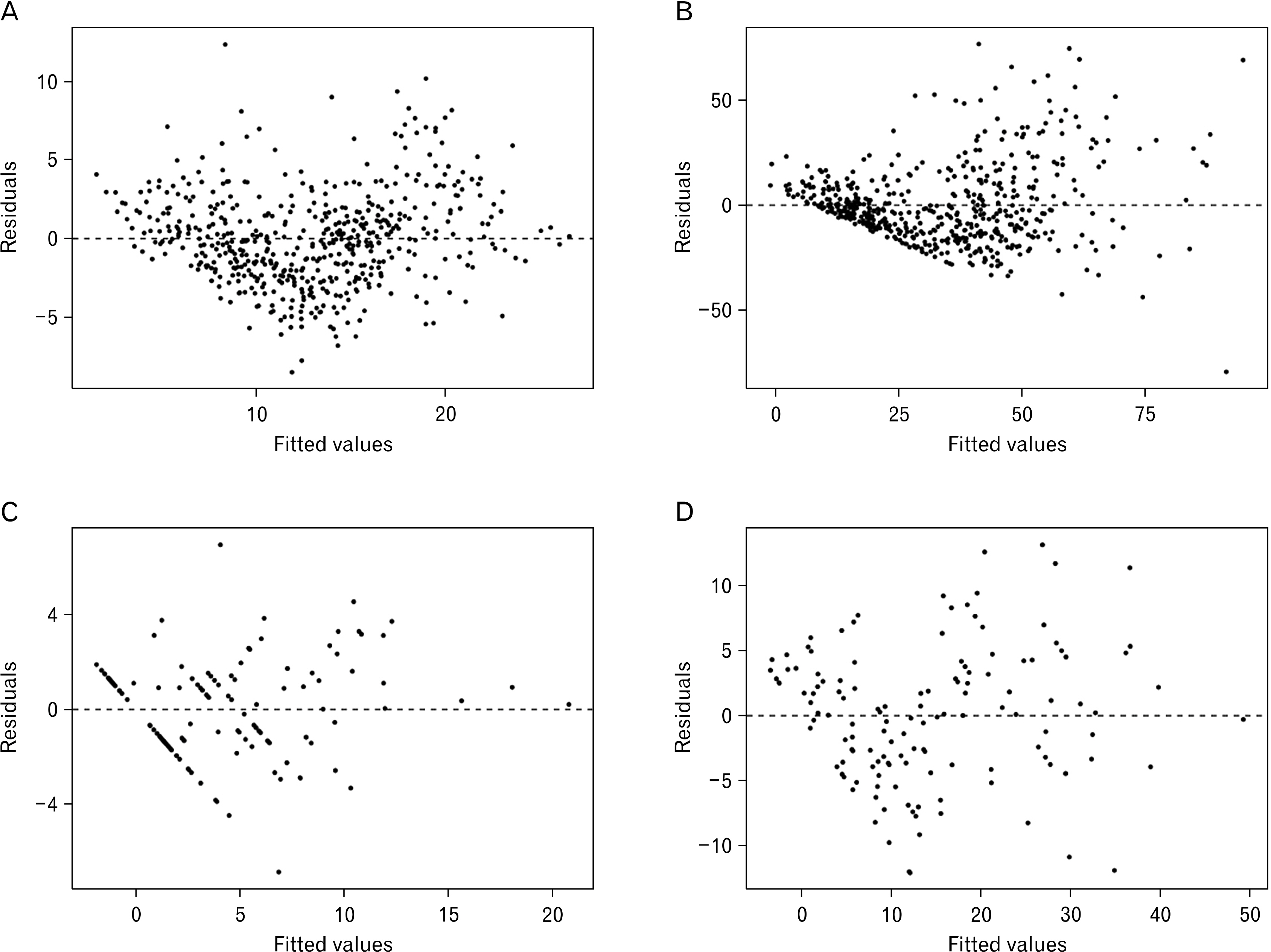Korean J Sports Med.
2024 Dec;42(4):280-288. 10.5763/kjsm.2024.42.4.280.
Effectiveness of a Mobile Application-Based Home Exercise Program for Postpartum Women with Abdominal Wall Dysfunction
- Affiliations
-
- 1Department of Orthopedic Surgery, Korea University Guro Hospital, Seoul, Korea
- 2Department of Radiology, Korea University Guro Hospital, Seoul, Korea
- 3Sports Medicine Center, Korea University Guro Hospital, Seoul, Korea
- KMID: 2561756
- DOI: http://doi.org/10.5763/kjsm.2024.42.4.280
Abstract
- Purpose
Diastasis recti abdominis (DRA) is a common issue among postpartum women, resulting in abdominal muscle weakness and associated problems such as back pain and urinary incontinence. However, compliance with exercise programs is often poor due to childcare demands. This study aims to assess changes in ultrasound parameters (inter-recti distance [IRD], shear wave elastography [SWE]) and patient-reported outcomes (PROs) related to DRA following an online exercise program.
Methods
Sixty-seven women aged 25–35 years, who had undergone single vaginal delivery, participated in an 8-week exercise program delivered via a mobile app. Pre- and post-intervention ultrasound parameters and clinical scores for low back pain (LBP) and urinary incontinence were compared.
Results
After the 8-week program, IRD decreased and SWE increased significantly. PROs, including scores for LBP and urinary incontinence, showed significant improvement. Subgroup analysis based on initial IRD diagnostic criteria for DRA revealed significant improvements in ultrasound parameters and PROs in both groups, with greater improvements observed in those initially diagnosed with clinical DRA.
Conclusion
The 8-week online exercise program through mobile application reduced IRD, SWE, and LBP-related disability and stress urinary incontinence. In particular, IRD showed a larger decrease than the decrease reported in a recent meta-analysis. These results suggest that an online exercise program
Figure
Reference
-
1. Noble E. Essential exercises for the childbearing year: a guide to health and comfort before and after your baby is born. 3rd ed. Houghton Mifflin;1988.2. Boissonnault JS, Blaschak MJ. 1988; Incidence of diastasis recti abdominis during the childbearing year. Phys Ther. 68:1082–6. DOI: 10.1093/ptj/68.7.1082. PMID: 2968609.3. Gilleard WL, Brown JM. 1996; Structure and function of the abdominal muscles in primigravid subjects during pregnancy and the immediate postbirth period. Phys Ther. 76:750–62. DOI: 10.1093/ptj/76.7.750. PMID: 8677279.4. Fast A, Weiss L, Ducommun EJ, Medina E, Butler JG. 1990; Low-back pain in pregnancy: abdominal muscles, sit-up performance, and back pain. Spine (Phila Pa 1976). 15:28–30. DOI: 10.1097/00007632-199001000-00008. PMID: 2139238.5. Liaw LJ, Hsu MJ, Liao CF, Liu MF, Hsu AT. 2011; The relationships between inter-recti distance measured by ultrasound imaging and abdominal muscle function in postpartum women: a 6-month follow-up study. J Orthop Sports Phys Ther. 41:435–43. DOI: 10.2519/jospt.2011.3507. PMID: 21289454.6. Bursch SG. 1987; Interrater reliability of diastasis recti abdominis measurement. Phys Ther. 67:1077–9. DOI: 10.1093/ptj/67.7.1077. PMID: 2955430.7. Richardson CA, Jull GA, Hodges PW, Hides JA. Therapeutic exercise for spinal stabilization: scientific basis and practical techniques. Churchill Livingstone;1999.8. Lee DG, Lee LJ, McLaughlin L. 2008; Stability, continence and breathing: the role of fascia following pregnancy and delivery. J Bodyw Mov Ther. 12:333–48. DOI: 10.1016/j.jbmt.2008.05.003. PMID: 19083692.9. Keeler J, Albrecht M, Eberhardt L, Horn L, Donnelly C, Lowe D. 2012; Diastasis recti abdominis: a survey of women's health specialists for current physical therapy clinical practice for postpartum women. J Womens Pelvic Health Phys Ther. 36:131–42. DOI: 10.1097/JWH.0b013e318276f35f.10. Awad E, Mobark A, Zidan AA, Hamada HA, Shousha TM. 2021; Effect of progressive prone plank exercise program on diastasis of rectus abdominis muscle in postpartum women: a randomized controlled trial. J Hum Sport Exerc. 16(2proc):S395–403. DOI: 10.14198/jhse.2021.16.Proc2.24.11. Bobowik PŻ, Dąbek A. 2018; Physiotherapy in women with diastasis of the rectus abdominis muscles. Adv Rehabil. 32:11–7. DOI: 10.5114/areh.2018.80964.12. Snoek JA, Prescott EI, van der Velde AE, et al. 2021; Effectiveness of home-based mobile guided cardiac rehabilitation as alternative strategy for nonparticipation in clinic-based cardiac rehabilitation among elderly patients in Europe: a randomized clinical trial. JAMA Cardiol. 6:463–8. DOI: 10.1001/jamacardio.2020.5218. PMID: 33112363. PMCID: PMC7593879.13. Salgueiro C, Urrútia G, Cabanas-Valdés R. 2022; Influence of core-stability exercises guided by a telerehabilitation app on trunk performance, balance and gait performance in chronic stroke survivors: a preliminary randomized controlled trial. Int J Environ Res Public Health. 19:5689. DOI: 10.3390/ijerph19095689. PMID: 35565084. PMCID: PMC9101754.14. Lee D, Hodges PW. 2016; Behavior of the linea alba during a curl-up task in diastasis rectus abdominis: an observational study. J Orthop Sports Phys Ther. 46:580–9. DOI: 10.2519/jospt.2016.6536. PMID: 27363572.15. Avery K, Donovan J, Peters TJ, Shaw C, Gotoh M, Abrams P. 2004; ICIQ: a brief and robust measure for evaluating the symptoms and impact of urinary incontinence. Neurourol Urodyn. 23:322–30. DOI: 10.1002/nau.20041. PMID: 15227649.16. Kopec JA, Esdaile JM, Abrahamowicz M, et al. 1995; The Quebec Back Pain Disability Scale: measurement properties. Spine (Phila Pa 1976). 20:341–52. DOI: 10.1097/00007632-199502000-00016. PMID: 7732471.17. Bates D, Mächler M, Bolker B, Walker S. 2015; Fitting linear mixed-effects models using lme4. J Stat Soft. 67:1–48. DOI: 10.18637/jss.v067.i01.18. Kuznetsova A, Brockhoff PB, Christensen RH. 2017; lmerTest package: tests in linear mixed effects models. J Stat Softw. 82:1–26. DOI: 10.18637/jss.v082.i13.19. Hanneford R, Tozer J. An investigation of the incidence, degree and possible predisposing factors of the rectus diastasis in the immediate postpartum period. J Nat Obstet Gynaecol. 1985; 4:29–32.20. Candido G, Lo T, Janssen PA. 2005; Risk factors for diastasis of the recti abdominis. J Assoc Chart Physiother Womens Health. 97:49–54.21. Yuan S, Wang H, Zhou J. 2022; Prevalence and risk factors of low back and pelvic pain in women with rectus abdominis diastasis: a multicenter retrospective cohort study. Korean J Pain. 35:86–96. DOI: 10.3344/kjp.2022.35.1.86. PMID: 34966015. PMCID: PMC8728546.22. Chiarello CM, Falzone LA, McCaslin KE, Patel MN, Ulery KR. 2005; The effects of an exercise program on diastasis recti abdominis in pregnant women. J Womens Pelvic Health Phys Ther. 29:11–6. DOI: 10.1097/01274882-200529010-00003.23. Rath AM, Attali P, Dumas JL, Goldlust D, Zhang J, Chevrel JP. 1996; The abdominal linea alba: an anatomo-radiologic and biomechanical study. Surg Radiol Anat. 18:281–8. DOI: 10.1007/BF01627606. PMID: 8983107.24. Qu E, Wu J, Zhang M, et al. 2021; The ultrasound diagnostic criteria for diastasis recti and its correlation with pelvic floor dysfunction in early postpartum women. Quant Imaging Med Surg. 11:706–13. DOI: 10.21037/qims-20-596. PMID: 33532270. PMCID: PMC7779936.25. Coldron Y, Stokes MJ, Newham DJ, Cook K. 2008; Postpartum characteristics of rectus abdominis on ultrasound imaging. Man Ther. 13:112–21. DOI: 10.1016/j.math.2006.10.001. PMID: 17208034.26. Tuttle LJ, Fasching J, Keller A, et al. 2018; Noninvasive treatment of postpartum diastasis recti abdominis: a pilot study. J Womens Pelvic Health Phys Ther. 42:65–75. DOI: 10.1097/JWH.0000000000000101.27. Keshwani N, Mathur S, McLean L. 2021; The impact of exercise therapy and abdominal binding in the management of diastasis recti abdominis in the early post-partum period: a pilot randomized controlled trial. Physiother Theory Pract. 37:1018–33. DOI: 10.1080/09593985.2019.1675207. PMID: 31642725.28. Laframboise FC, Schlaff RA, Baruth M. 2021; Postpartum exercise intervention targeting diastasis recti abdominis. Int J Exerc Sci. 14:400–9. DOI: 10.70252/GARZ3559.29. Leopold M, Santiago K, Cheng J, et al. 2021; Efficacy of a core strengthening program for diastasis rectus abdominis in postpartum women: a prospective observational study. J Womens Pelvic Health Phys Ther. 45:147–63. DOI: 10.1097/JWH.0000000000000214.30. Benjamin DR, Frawley HC, Shields N, et al. 2023; Conservative interventions may have little effect on reducing diastasis of the rectus abdominis in postnatal women: a systematic review and meta-analysis. Physiotherapy. 119:54–71. DOI: 10.1016/j.physio.2023.02.002. PMID: 36934466.
- Full Text Links
- Actions
-
Cited
- CITED
-
- Close
- Share
- Similar articles
-
- Development and Validation of a Postpartum Care Mobile Application for First-time Mothers
- Developing a Mobile-Based Exercise Program to Reduce Fear of Falling
- Effects of a Postpartum Care Program for Postpartum Women on Postpartum Activity and Postpartum Discomfort in Primiparous Women
- Feasibility of Mobile Health App-Based Home Aerobic Exercise for Physical Performance in Healthy Young Adults
- Research of Home-Based Exercise Program Development and Effect Analysis: Prevention of Sarcopenia in Hemiplegic Disorder





